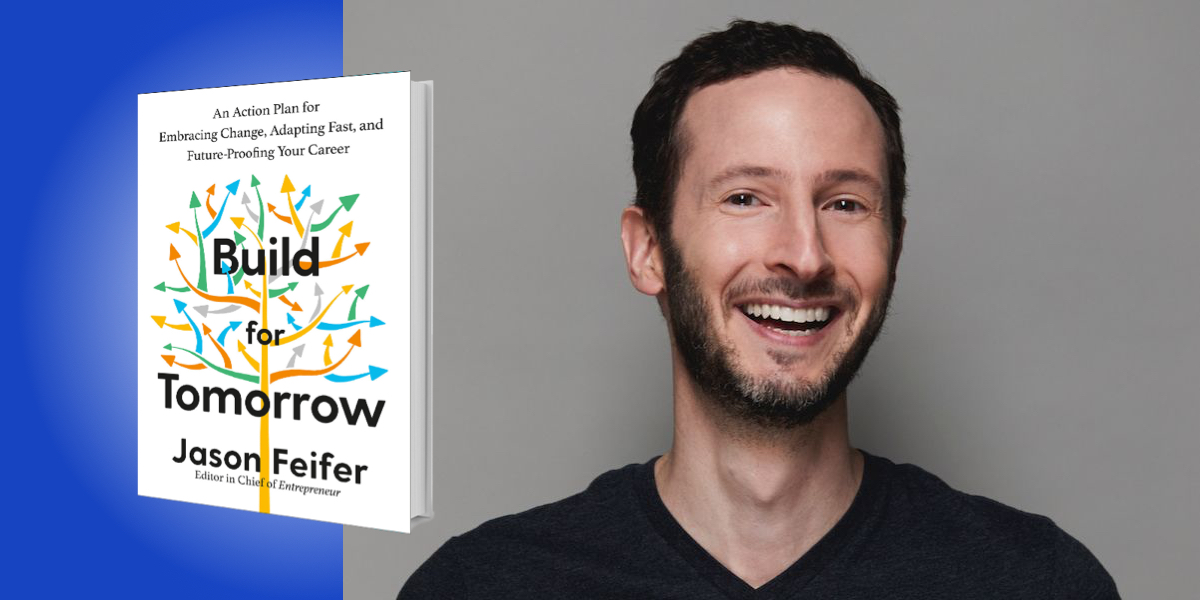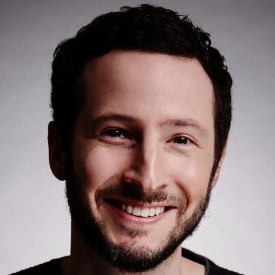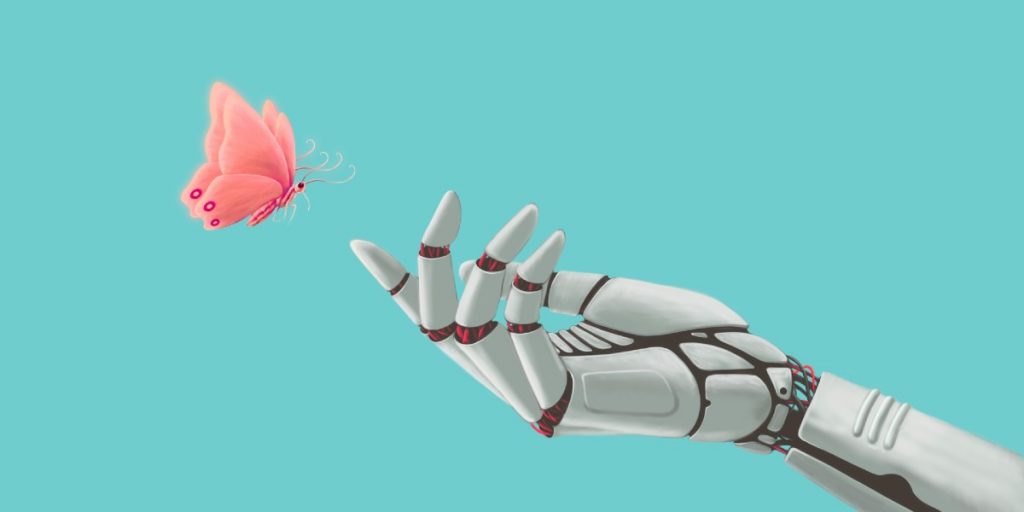Jason Feifer is the editor-in-chief of Entrepreneur magazine. He hosts two popular podcasts—Build for Tomorrow and Problem Solvers—for which he studies the history of innovation.
Below, Jason shares 5 key insights from his new book, Build for Tomorrow: An Action Plan for Embracing Change, Adapting Fast, and Future-Proofing Your Career. Listen to the audio version—read by Jason himself—in the Next Big Idea App.
1. Find the thing that does not change, even in times of change.
The first thing a person should do when navigating change is to identify the thing about themself that is not going to change. This is tough because we naturally identify with the output of our work. If somebody at a party asks you what you do, you’re either going to tell them your job title, your role, the way in which you do your work, or the thing that you create. And that’s natural—it’s a good way to understand ourselves.
But the problem is that when we identify too closely with our work we tie our very identity to something that’s changeable. So, when change finally comes along, we feel totally disoriented. The solution is identifying a mission statement, something so core to us that it does not change despite anything that happens around us. This provides a sense of orientation in times of disorientation. The best way to do this is to come up with a single sentence. Write a few words down, have it start with I, and make sure that none of those words can be easily disrupted.
In my case, I started my career in newspapers. Once I identified as a newspaper reporter, I felt lost when I decided newspapers weren’t for me—this wasn’t just giving up a job, it was giving up an identity. I eventually realized that a better way to define myself is I tell stories in my own voice. Stories, regardless of if that means in a newspaper, magazine, or book. When we find this core, this why, this thing that drove us to develop the skills that enable our work tasks in the first place, then we will know what part of us does not change. We will know our mission statement and how to provide value even when things start feeling unfamiliar.
2. In order to be good at something, you have to be willing to be bad.
That’s something Ryan Reynolds told me. Ryan is an actor who also started an extremely successful advertising agency called Maximum Effort. He also owns Aviation Gin and Mint Mobile. Ryan told me that the thing that distinguishes people is not whether they’re good at something at the beginning (because nobody will be good at something at the beginning), but rather whether someone can tolerate the natural state of being bad at the beginning. When trying something new, there cannot be an expectation of mastery from the start.
“Whenever I do something new I say to myself, I can’t wait to do this the second time.”
If you’re starting out being a painter, you know what good paintings look like, and you know that you cannot produce them yet. The question is whether you can tolerate the discomfort of not doing well. As a result, whenever I do something new I say to myself, I can’t wait to do this the second time. When you frame the first time as a means to do it a second time, the stakes feel different and this new thing seems like it can be tackled after all.
3. Work your next job.
In front of you are two sets of opportunities. Opportunity Set A is everything that is asked of you, for instance showing up at your job, things your boss needs done, etc. It is necessary to do a good job at Opportunity Set A. Opportunity set B is everything that is available for you to do that nobody is asking you to do. This could also be at your job, but it could also be something outside of work like taking a class to learn a new skill.
Set B is always more important—infinitely more important. If you only focus on Set A, then you will only be qualified to do the thing you’re already doing. But by focusing on Opportunity set B, you can eventually incorporate new modes into the way in which you operate.
And you don’t necessarily need to know the point of what you’re learning upfront. For instance, if you start writing a book, you don’t have to know if you’re going to sell the book when it’s done. Simply having started doing a new thing opens opportunities. It could be months or years later when there will be an opportunity, or you will be seeking a change and it might turn out that this thing that you had worked on is the thing that will ultimately drive you forward. It’s going to be the thing that opens new doors for you. Always, always, always focus on Opportunity Set B.
4. Is the new problem better than the old problem?
Too often, we ask ourselves, Is this perfect? We’ll start a new thing and decide something is not quite right, identify a problem, and then feel like the whole thing is wrong.
“If we filtered our lives for perfection, we would throw every single thing out.”
As I record this, my seven-year-old son started a new school. He’s two weeks into it and it’s going okay, but my wife is extremely concerned because he doesn’t have a large group of friends and complains when he comes home. She’s looking for signs of perfection. She wants to see that he’s instantly thriving, but that’s not how things happen. It’s better to ask ourselves, Is our new problem better than our old problem? This question allows for problems. Nothing is perfect.
In starting a new job, things won’t be perfect. When engaging with new technology, the interaction won’t be perfect. If we filtered our lives for perfection, we would throw every single thing out. Instead, have confidence if the new problem is better than the old problem. My kid going to a new school solved a bunch of other problems, and now there are new problems in the adjustment period. For us, that’s a better new problem than some of the old problems. By reframing everything in terms of a better or worse problem, then you can digest problems and focus on progress.
5. What is it for?
With every single thing you do, ask What is it for? This forces you to make sure that the things that you do have a valuable outcome. It’s okay if that outcome looks strange, or if that outcome will come after some time working towards it. We want to know which things we should devote our time and energy to, and we want to understand how to maximize opportunities. Answering What is it for? clarifies that.
For example, I run a print magazine at a time in which print magazines are often considered a dying art. Many magazines have closed. Those that haven’t don’t sell as well as they used to. People often ask me, “You’re a guy who embraces and preaches the power of change, so why are you putting out a print magazine?” Frankly, part of the answer is that Entrepreneur magazine still makes money, so there’s no reason to kill it off. But the bigger answer comes from, What is it for?
A couple of decades ago, you might have said that content is for monetization and money is made off of content. Back then, magazines could sell ads and sell subscriptions as two great ways to make money off of content. But now, that’s harder because Facebook and Google have gobbled up the bulk of the world’s advertising budget. Also, people don’t pay to subscribe to things as much as they used to.
“Knowing what content is for allows for shifts in its production and the way in which content producers engage with consumers.”
So, What is it for? Content now is for relationships. People will trust you and like you because of content. You build a relationship with people when you put something out into the world. Businesses monetize the relationship people have with products and services because the consumers buy the product when they like the content. Knowing what content is for allows for shifts in its production and the way in which content producers engage with consumers. We can think differently about the whole business model so that it is shaped for what people need in today’s reality. Asking What is it for? reframed how I work. Imagine what will happen if you ask that of everything you do.
I host a podcast of the same name as this book, Build for Tomorrow. This podcast doesn’t make much money. I spend more time on it than I earn back. What is it for? It’s for opportunity. The podcast is an opportunity magnet. I put it out there, people find it, they develop relationships with me. It’s sort of a version of content is for relationships. I’ve done a lot of things as a result of people who find the podcast and then present me with an opportunity. This book came out of the podcast. As long as you can answer what is it for, you can keep going, changing, and building.
To listen to the audio version read by author Jason Feifer, download the Next Big Idea App today:
































